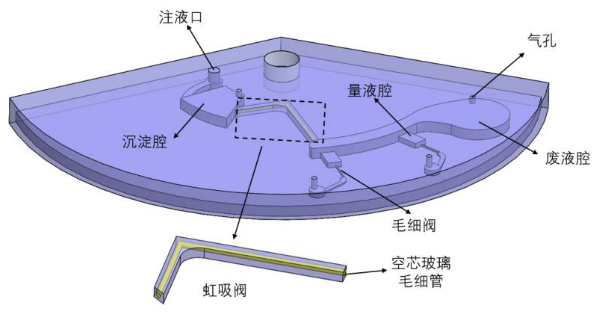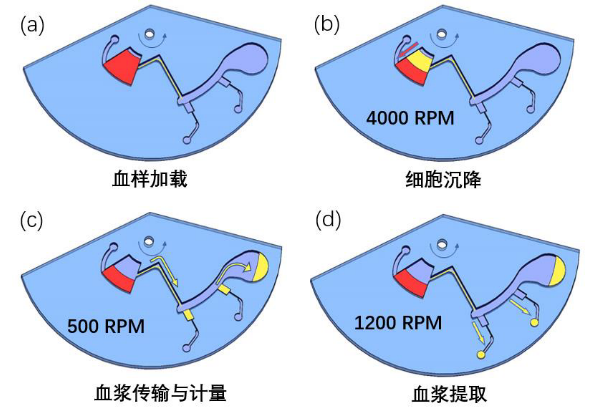This article utilizes hollow glass capillaries to achieve siphon valve effects by embedding specifically shaped hollow glass capillaries at the siphon valve location. By leveraging the inherent hydrophilicity of the inner walls of the hollow glass capillaries, local hydrophilicity is achieved without altering the overall surface characteristics of the chip, thus facilitating siphon drainage.Figure 1 shows a microfluidic chip designed by the authors for whole blood separation to validate the hollow glass siphon structure.The principle of the siphon valve can be seen in the centrifugal microfluidic chip siphon valve (1) and centrifugal microfluidic chip siphon valve (2).For more information on whole blood, refer to: An ultra-efficient microfluidic chip for whole blood separation, a self-sampling microfluidic chip for whole blood pathogen detection, a microfluidic chip for extracting white blood cells from whole blood, a microfluidic chip for white blood cell extraction from whole blood, and a microfluidic device for analyzing biomarkers in small volume (5ul) whole blood samples (with video).This structure mainly consists of a sedimentation chamber, a siphon valve, a spiral distribution channel, two measurement chambers, and two capillary valves, where the siphon valve connects the upstream sedimentation chamber with the downstream spiral distribution channel.During the centrifugation of whole blood in the sedimentation chamber, the siphon valve remains closed until the blood has fully separated, at which point the siphon valve opens to drain the upper plasma into the downstream spiral distribution channel for subsequent quantitative extraction.
Figure 1
The sedimentation chamber is designed in a trapezoidal shape, narrower at the top and wider at the bottom, which facilitates the sedimentation of red blood cells at the bottom while allowing the upper plasma to distribute radially as much as possible.In the specific design of the siphon valve structure, the most critical aspect is the selection of the valve inlet position, which must be above the interface of the blood layers to ensure that the siphon drains the upper plasma.Considering that the hematocrit level in blood depends on the donor’s gender, health status, and type, the hematocrit in human blood ranges from 30% to 52%.To address the expected variation in red blood cell quantity, the authors designed the valve inlet position based on a hematocrit level of 52%, fixing the siphon valve inlet position above the volume of red blood cells to ensure that only the acellular plasma portion is transferred into the collection chamber.The preprocessing flow of whole blood samples on the chip is shown in Figure 2.
Figure 2
Fabrication of hollow glass capillariesThe authors selected a hollow glass capillary with a length of 20 mm and an inner diameter of 300 μm. To obtain a glass capillary that can be embedded at the reserved siphon valve position, the capillary must first be shaped into the required siphon valve form. This is achieved by bending the glass capillary at high temperatures using a butane torch to the angle required for the reserved siphon channel (set to a right angle for ease of fabrication). The ends of the formed glass capillary are then cut using a fiber optic cutting tool to achieve the appropriate length.Next, the “L” shaped glass capillary is carefully placed into the reserved channel of the mold and fixed with UV-curable adhesive. After normal encapsulation, it can be used as a siphon valve.Additionally, to further enhance the hydrophilicity of the inner walls of the glass capillary and ensure the normal operation of siphon flow control, the inner walls of the glass capillary can be treated for hydrophilicity.
References
Research on a Centrifugal Microfluidic Immunoturbidimetric Detection System
—————————————————————-
Selected past articles:
A chemiluminescent centrifugal chip
A one-stop single-cell gene analysis platform
A microfluidic chip fluid switching valve
A capillary-driven continuous flow PCR microfluidic chip
A handheld pen-like paper strip detection device
A paper-based microfluidic chip for immunoreactions
An all-integrated centrifugal microfluidic chip based on column method nucleic acid extraction
A microfluidic chip for absolute quantification digital PCR
A paper-based microfluidic device with reagent storage and nucleic acid extraction functions
A multiplex microfluidic chip for COVID-19 detection (chip + instrument)
A microfluidic chip for liquid biopsy biomarker (ctDNA) detection